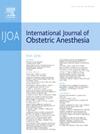调查黑人和白人妇女分娩硬膜外镇痛管理的差异:一项回顾性病例对照研究(2018-2022)。
IF 2.6
3区 医学
Q2 ANESTHESIOLOGY
引用次数: 0
摘要
背景:分娩时硬膜外镇痛(LEA)管理的差异会降低产妇满意度,增加分娩风险。我们比较了从首次使用突破性止痛药(补充)到更换LEA的时间,以评估种族间的差异。方法:在这项回顾性队列研究中(2018年1月1日至2022年12月31日),所有LEA患者和母亲种族/民族为非西班牙裔白人或黑人。结果:共有11168例患者接受了LEA,其中白人患者为479例(5.5%),黑人患者为127例(5.0%)。有387例(3.5%)lea在24小时内充值并更换。调整混杂因素后,未发现种族与LEA管理之间存在关联(风险比0.82;95% ci 0.63, 1.06;p = 0.13)。我们未能发现患者种族与置换发生率之间的关联(P = 0.23)。我们发现种族(P = 0.02)和LEA替代(P)。结论:我们没有发现在我们机构采用标准化LEA管理方案的治疗存在差异。然而,黑人女性和接受LEA置换的女性则不太满意。未来的研究应评估其普遍性,并探索提高患者满意度的干预措施。本文章由计算机程序翻译,如有差异,请以英文原文为准。
Investigating disparity in labor epidural analgesia management in black vs. white women: a retrospective case-control study (2018–2022)
Background
Disparities in labor epidural analgesia (LEA) management could reduce maternal satisfaction and increase risk. We compared times from the first administration of breakthrough pain medication (top-up) to LEA replacement to evaluate disparities across race.
Methods
In this retrospective cohort study (01-01-2018 to 12-31-2022), all patients with LEA and maternal race/ethnicity of non-Hispanic White or Black were eligible. Patients with a scheduled cesarean delivery, previous back instrumentation, or maternal age < 18 were excluded. We used a Cox Proportional Hazards model to evaluate our primary outcome. Predefined top-up medications given ≥60 minutes from initial LEA placement and before replacement were valid. Any replacement ≥60 minutes from the initial LEA was valid. We also studied secondary outcomes incidence of epidural replacement and postoperative patient satisfaction.
Results
There were 11,168 total patients receiving LEA, with 479 (5.5%) replacements in White patients and 127 (5.0%) in Black patients. There were 387 (3.5%) LEAs with a top-up followed by replacement within 24 hours. After adjusting for confounders, no association was detected between race and LEA management (Hazard Ratio 0.82; 95% CI 0.63, 1.06; P = 0.13). We failed to detect an association between patient race and the incidence of replacement (P = 0.23). We found that race (P = 0.02) and LEA replacement (P < 0.001) were associated with increased odds of lower postpartum satisfaction.
Conclusions
We didn’t detect disparity in treatment at our institution with standardized LEA management protocols. However, Black women and those with LEA replacements were less satisfied. Future studies should evaluate the generalizability and explore interventions that improve patient satisfaction.
求助全文
通过发布文献求助,成功后即可免费获取论文全文。
去求助
来源期刊
CiteScore
4.70
自引率
7.10%
发文量
285
审稿时长
58 days
期刊介绍:
The International Journal of Obstetric Anesthesia is the only journal publishing original articles devoted exclusively to obstetric anesthesia and bringing together all three of its principal components; anesthesia care for operative delivery and the perioperative period, pain relief in labour and care of the critically ill obstetric patient.
• Original research (both clinical and laboratory), short reports and case reports will be considered.
• The journal also publishes invited review articles and debates on topical and controversial subjects in the area of obstetric anesthesia.
• Articles on related topics such as perinatal physiology and pharmacology and all subjects of importance to obstetric anaesthetists/anesthesiologists are also welcome.
The journal is peer-reviewed by international experts. Scholarship is stressed to include the focus on discovery, application of knowledge across fields, and informing the medical community. Through the peer-review process, we hope to attest to the quality of scholarships and guide the Journal to extend and transform knowledge in this important and expanding area.

 求助内容:
求助内容: 应助结果提醒方式:
应助结果提醒方式:


